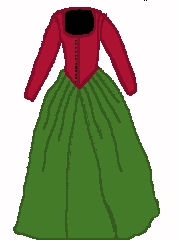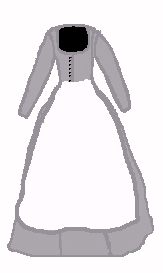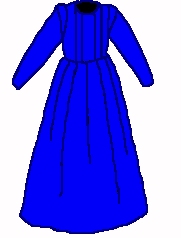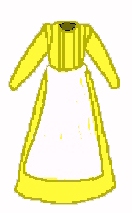


 A woman's undergarment was a long off-white short-sleeved, linen shirt, resembling a modern-day woman's nightshirt except that it was ribbon-tied at the collar and cuffs and fastened in the front. One or more ankle-length, waist-fastened petticoats were worn. The gown, consisted of two parts, a bodice and a skirt--sometimes the sleeves were a separate part as well, being tied to the bodice. The bodice or the skirt could be the same or different colors, and were made of wool. The bodice buttoned all the way down the front. The skirt was ankle-length and gathered at the waist. A long-sleeve fitted waistcoat was often worn over the top, and an apron was worn if the woman was doing any kind of work. Women occasionally wore lace collar and cuffs, and a cloak. Women's hair was always worn up and pulled tightly back, and worn under a hat.
A woman's undergarment was a long off-white short-sleeved, linen shirt, resembling a modern-day woman's nightshirt except that it was ribbon-tied at the collar and cuffs and fastened in the front. One or more ankle-length, waist-fastened petticoats were worn. The gown, consisted of two parts, a bodice and a skirt--sometimes the sleeves were a separate part as well, being tied to the bodice. The bodice or the skirt could be the same or different colors, and were made of wool. The bodice buttoned all the way down the front. The skirt was ankle-length and gathered at the waist. A long-sleeve fitted waistcoat was often worn over the top, and an apron was worn if the woman was doing any kind of work. Women occasionally wore lace collar and cuffs, and a cloak. Women's hair was always worn up and pulled tightly back, and worn under a hat.
Common colors were red-browns, earthy greens, browns, and greys. Contrary to popular stereotype, black was not a common color for women's dresses.
 For the upper body, men usually wore a long, short-sleeved, off-white linen shirt, with collar. On top of that he wore a doublet, which was relatively close-fitting,
with long sleeves, broad padded shoulders, and buttoned down the front with tabs at waist. A cloak was often draped over the shoulders. A lace collar and cuffs were worn, as was a felt hat or cap. Older or more revered men often wore over the top of everything a full-length wool gown similar to a modern-day bathrobe.
For the upper body, men usually wore a long, short-sleeved, off-white linen shirt, with collar. On top of that he wore a doublet, which was relatively close-fitting,
with long sleeves, broad padded shoulders, and buttoned down the front with tabs at waist. A cloak was often draped over the shoulders. A lace collar and cuffs were worn, as was a felt hat or cap. Older or more revered men often wore over the top of everything a full-length wool gown similar to a modern-day bathrobe.
For the lower body, breeches were usually worn. Breeches are front-buttoning pants which extend to the knee level, and were relatively baggy. Stockings were knee-length, and resemble modern-day women's opaque tights. Shoes were generally low-heel, low cut leather shoes.
Whites, beiges, blacks, earthy greens, and browns were the predominant colors in men's clothing. Black was not the predominant color except for on Sunday or formal occasions.

 Young boys (to about age 8) ( see picture on left) and girls (see picture on right) both wore dresses, generally made of either wool or linen. The skirt was full length, and the bodice was long sleeved and laced in the back, with a high neckline.
Young boys (to about age 8) ( see picture on left) and girls (see picture on right) both wore dresses, generally made of either wool or linen. The skirt was full length, and the bodice was long sleeved and laced in the back, with a high neckline.
The color blue was common for children--girls as well as boys--and other colors were grey, red, earthy greens, yellows, and browns.
About the age of nine or ten, boys began to wear clothing similar to their fathers, and girls began to wear dresses cut more like those of their mothers.
The Thanksgiving Primer, by the Plimouth Plantation, 1991.
A Little Commonwealth, by John Demos, 1970.
Patterns of Fashion: the Cut and Construction of Clothes for Men and Women, c1560-1620, by Janet Arnold, 1985.
Handbook of English Costume in the Seventeenth Century, by C. Willet and Phillis Cunnington, 1955.
Two Centuries of Costume in America, 1620-1820, by Alice Morse Earle, repr. 1903.
Period Costume for Stage and Screen: Patterns for Women, 1500-1900, by Jean Hunnisett, 1983.

